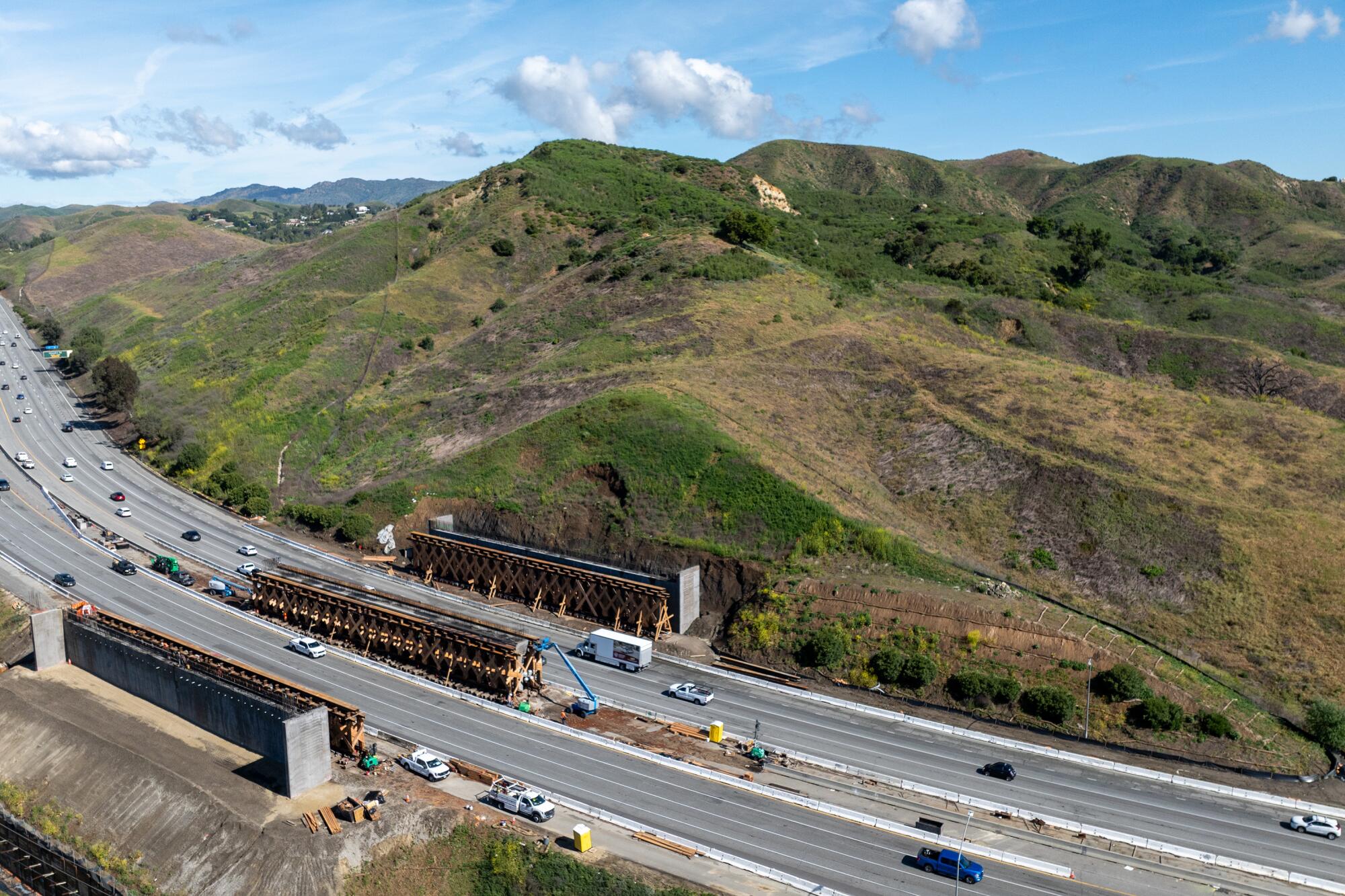
A vision to provide safe passage for mountain lions above 10 lanes of whizzing traffic near Los Angeles faced a foe: time.
Genetically isolated pumas hemmed in by the 101 Freeway were showing birth defects and needed an outlet fast.
A massive philanthropic challenge grant allowed the $92-million Wallis Annenberg Wildlife Crossing to advance rapidly and encouraged state investment — and the underlying collaborative model has inspired a new effort to build passages for animals across the state.
Wednesday saw the launch of California Wildlife Reconnected, an initiative dreamed up by Gov. Gavin Newsom, state agencies and nonprofits to leverage public and private resources to develop and swiftly implement a statewide plan for wildlife connectivity.
“There’s been a growing awareness in California as we’re working to protect our nature, our biodiversity, that we can’t just restore and protect habitat; We actually have to build connectivity between habitat,” said Wade Crowfoot, secretary for the California Natural Resources Agency, which hosted a news conference announcing the initiative.
Aggressive and impactful reporting on climate change, the environment, health and science.
While the momentum is there, evinced by an increase in state and federal investment, it’s not enough, he said.
“Sometimes that [public] funding can’t be allocated quickly enough to get these projects planned so that they can be up and running quickly,” Crowfoot said. “We know that we’re in a race against time regarding these climate impacts and other stressors on habitat.” (The initiative dovetails with the state’s goal to conserve 30% of its lands and coastal waters by 2030, known as 30x30.)
That’s where philanthropy can come in.
Crowfoot described it as “a philanthropic effort to turbocharge the wildlife crossings movement.”
Beth Pratt, California regional executive director for the National Wildlife Federation, who raised millions for the crossing over the 101 — the largest structure of its kind in the world — is one of the forces behind the public-private initiative.
Pratt founded the Wildlife Crossing Fund, a nonprofit that aims to raise $500 million to match public funding to start knocking out projects in California and beyond. Philanthropist Wallis Annenberg has pledged a $10-million matching grant, and $2.2 million has already been raised, according to a news release.
One project slated to benefit from the initiative is a wildlife crossing geared toward mule deer migrating across Highway 395 near Mammoth — “a huge deer kill area,” Pratt said while on the California leg of a road trip intended to raise awareness for connectivity issues.
She said the initiative is committed to funding final design and engineering, with the possibility of starting construction in 2027.
New aerial footage shows the Annenberg Wildlife Crossing starting to take form over the 101 Freeway in Agoura Hills.
While big fauna, like pumas and deer, often get outsized attention, the initiative aims to build crossings for more minute critters too. Pratt said they’ve hoping to get a Yosemite toad crossing at Tioga Pass, similar to one already in place at Sonora Pass.
Funding is one major piece of the puzzle; planning is another.
According to Pratt, California Wildlife Reconnected was modeled on a Florida effort that brought together elected officials, nongovernmental organizations and business partners to create a statewide plan to create a wildlife corridor.
“We … have a responsibility to integrate planning for wildlife connectivity moving forward,” Crowfoot said.
As required by recent legislation, the California Department of Transportation, a founding partner of California Wildlife Reconnected, in coming weeks will release its priorities for wildlife connectivity. The California Department of Fish and Wildlife undertook a similar effort, finding that most barriers were related to state highways, but that railways and canals also pose challenges.
U.S. Sen. Alex Padilla of California announced proposed federal legislation earlier this summer to support wildlife connectivity. Companion legislation was introduced in the House of Representatives.
All the hype around wildlife crossings is relatively new.
“It’s a really different flavor than it was, you know, I’d say even three years ago,” said Neal Sharma, senior manager of the Wildlife Conservation Network’s California Wildlife Program. The nonprofit has pledged $1 million to the Wildlife Crossing Fund.
Part of the credit for galvanizing the movement is owed to a charismatic public figure — a late mountain lion known as P-22.
P-22’s historic stint in Griffith Park, a wilderness area in Los Angeles, captured the hearts of residents and helped elevate the plight of pumas hemmed in by freeways and development.
A mountain lion spotted at the edge of Griffith Park last month recalled the park’s former feline king, P-22. If the new cougar stays, he’ll face the same challenges as his predecessor.










